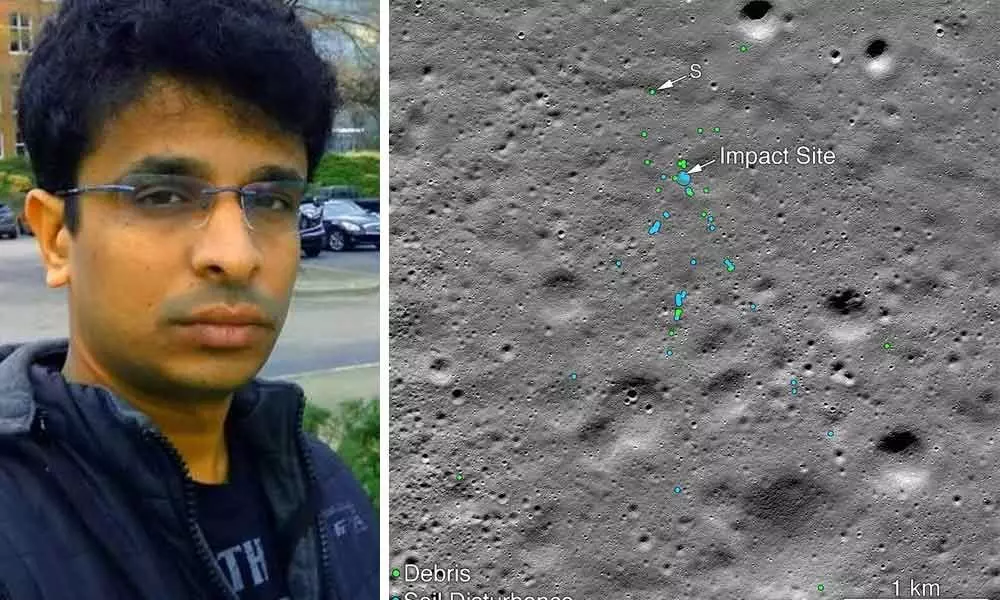Live
- New Criminal Laws: An Era of Transformation of the Criminal Justice System
- India among top 10 countries with AI readiness: Report
- UNICEF to support Kerala's children with special needs
- Meta purges over 2 million accounts linked to scam centres
- Mumbai, Delhi ranked among top 5 prime residential markets in Asia-Pacific
- Russia provided North Korea with anti-air missiles in exchange for troop deployment
- PCB appoints Azhar Ali as head of youth development
- Deepam-2 Scheme Reaches 5 Million Beneficiaries in Three Weeks, says Nadendla Manohar
- Will RG Kar tragedy impact Bengal bypoll results?
- BGT 2024:25: Josh Hazlewood picks four as Australia bundle out India for 150
Just In
Chennai techie helps NASA find Vikram lander on Moon


Despite a frantic search for the Vikram Moon lander by scientists at ISRO and US space agency NASA for over two months since it disappeared on Moon's surface on September 7, it's a techie from Chennai who was finally able to unravel the biggest mystery in India's space history so far.
Washington: Despite a frantic search for the Vikram Moon lander by scientists at ISRO and US space agency NASA for over two months since it disappeared on Moon's surface on September 7, it's a techie from Chennai who was finally able to unravel the biggest mystery in India's space history so far.
NASA, the US space agency, has credited Subramanian, a mechanical engineer and a computer programmer from Chennai, for helping it find ISRO's Vikram Moon lander debris on the lunar surface.
He works as a technical architect at engineering company Lennox India Technology Centre in Chennai.
As per NASA, its Lunar Reconnaissance Orbiter Camera (LROC) had released the first set of pictures of the Chandrayaan-2's Vikram lander contact site on September 26.
It said many people, including Shanmuga Subramanian, were searching for the lander, which lost contact with the ISRO just before soft-landing on the Moon.
Shanmuga's crucial inputs helped NASA confirm the Vikram lander debris location by comparing before and after images. "Shanmuga Subramanian contacted the LRO project with positive identification of debris.
After receiving this tip, the LROC team confirmed the identification by comparing before and after images," the agency said, crediting Subramanian for finding debris identified as "S".
In an email to The New York Times, Subramanian said he was among several curious Indians who were searching for the Vikram lander.
"The crash landing of Vikram rekindled an interest in the moon not only for me and others also," he wrote, adding that, "I think even if Vikram had landed and sent some images, but we also would have never had such interest.
For the first few days, I was scanning the images randomly and there were a lot of false positives." During his random searches at his spare time, Subramanian noticed a white speck around the Moon touchdown site pictures released by NASA.
This bright pixel, he said, was not visible in earlier images released by the space agency.
"Is this Vikram lander? (1 km from the landing spot) Lander might have been buried in Lunar sand?" he wrote in an October 3 tweet, tagging both ISRO and NASA.
Thanking Subramanian for an interesting observation, NASA deputy project scientist (LRO mission) John Keller said its LROC team confirmed that location did exhibit changes in images taken before and after the day of landing.
"Using this information, the LROC team did additional searches in this area and located the site of the primary impact as well as other debris around the impact location," Keller wrote to Subramanian.
He also appreciated Subramanian for his efforts. "Congratulations for what I am sure was a lot of time and effort on your part. You will probably get some enquiries from the press on your discovery."
Releasing pictures of the contact site, NASA said the debris first located by Subramanian is about 750 metres northwest of the main crash site. "
(It) was a single bright pixel identification in that first mosaic (1.3-metre pixels, 84-degree incidence angle). The November mosaic shows best the impact crater, ray and extensive debris field. The three largest pieces of debris are each about 2x2 pixels and cast a one-pixel shadow," the agency said.
The Chandrayaan 2's Vikram lander was targeted to land on Moon's highland smooth plain, about 600 km from its the South Pole.
However, India's attempt to create history by becoming the first nation to land on the South Pole had faced setback after Vikram lander lost communication just before the scheduled touchdown on September 7.
NASA had earlier made two attempts to locate Chandrayaan 2's lander on September 17 and October 14 but to no avail.
The agency had cited two reasons for its inability to trace Chandrayaan 2's Vikram lander -- one, the lander might be lying in shadowed part of the moon or second, it might be located outside the area US space agency photographed.

© 2024 Hyderabad Media House Limited/The Hans India. All rights reserved. Powered by hocalwire.com






